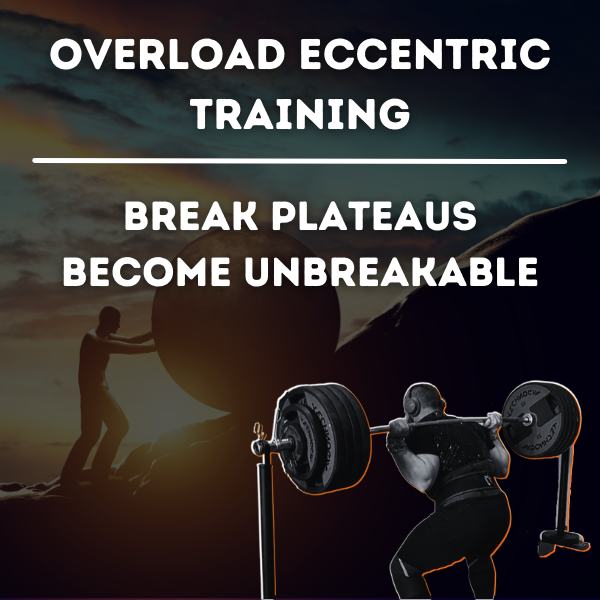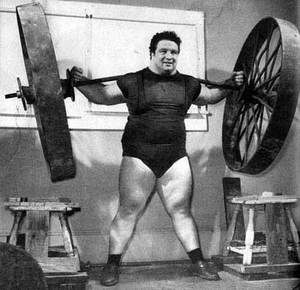Eccentric Training
How long have your numbers been stuck? How long have you been riding the latest plateau in training, waiting to see when you’ll see the progression you’re after?
Today’s article is going to uncover the secrets of arguably, the most effective strength training modality known to man – Overload Eccentric Training
To add to the strength plateaus, do you ever feel like your strength issues comes from “poor coordination” or stability? Many people struggle with the ability to control their body position, particularly when performing newer exercises. Although this is a product of kinaesthetic awareness, stability is significantly influenced by your eccentric strength.
Time to sink our teeth into some strength science!
WHAT?
What Do We Mean By Eccentrics in Training?
Muscles work in 3 different ways when under active tension:
- Concentric: this is the method of muscle action most people are familiar with. The shortening of muscle fibers under tension, or in other words, the “lifting of a weight”.
- Isometric: The origin of the Unshakable Strength Program – We’ve written an entire guide on this method of training previously. This is where the muscle is under active tension, but there is no significant change in muscle length and no movement actually occurs. E.g. pushing as hard as you can against a wall.
- Eccentric: this is the one most bodybuilders are familiar with due to the “muscle damage” aspect of the motion. This is where the muscle lengthens under tension, or in other words, the lowering of a weight.

While there is no perfect method of training, the key fault in our approach to training, often comes from the fact we only focus on the concentric portion of the movement.
How much Do you Lower Bro?
Let’s face it. No one cares. Throughout historical accounts of remarkable feats of strength, people only really document what someone was able to lift from A to B or hold in position. But there are very few (if any) records of what someone was able to lower under control.
Historical Examples of Feats of Strength - Derek Poundstone's 2000lb+ Back Lift + Mark Felix's Infamous Hercules Hold World Record
But after you read today’s article, you’ll realise one thing – the whole lifting world, would be a whole lot stronger, fitter and faster if we placed just as much value on Eccentric Training as we do everything else.
The Three Key Benefits
This is far from a completely exhaustive list, up next are the key benefits you can expect to gain from implementing eccentric focused training into your regime.
1. It Makes You Strong
Like. Really f*cking strong.
Research by Hortobagyi et al. (10) found that even when adding weight to the eccentric contraction (around 50% additional weight), subjects gained 2.0x more strength when compared to a traditional training group (who lifted and lowered the same amount of weight).
Now you could say that it’s because the first group simply did more training volume. However, this study accounted for that, decreasing the total reps down by the eccentric overload group to make sure the total weight lifted (sets x reps x load) was the same.
Continuing from above, another study found a 29% vs. 19% increase in eccentric enhanced vs. traditional training in the hamstrings muscle group (13). In fact, a recent systematic review summarised that using loads in eccentric training (that were not limited by what you could lift) was a superior mode of training, which…
…“Appears to be superior to traditional resistance training in improving variables associated with strength, power and speed (3)”.
That’s right…Eccentric training (although it emphasizes the lowering phase), can directly increase the strength within the lifting phase. Because you are able to train at a higher intensity (e.g. handle weight up to 40% heavier), you can become stronger, even if you never lifted a weight.
Eccentric overload training has been shown to result in significant strength gains and even greater gains in jump height when compared to traditional training (7). In fact, the researchers stated that
“enhanced eccentric load led to a subtly faster gene expression pattern, inducing a shift towards faster muscle phenotypes”.
In other words, the increased intensity that your body is able to access during Eccentric Training, can create an epigenetic response, that alters your body’s physiological makeup, resulting in increased power and speed, alongside strength.
2. Faster Technique – Cognitive Overload
If there is one aspect of eccentric training that truly amazed me, it’s this one. Get your nerd hat on.
Cortical activity is the term given to what is going on in the cerebral cortex, in reference to how we experience movement and how we interact with our environment. Different types of exercise results in changes in cortical activity (6), that differs depending on both the exercise mode and intensity employed (2, 5).

This is the craziest part. When it comes to stability, we know that synergist muscles (stabilising muscles that contribute to the movement alongside the prime movers) are incredibly important, those who don’t have stability tend to show case weakness in this area. However, eccentric exercise has been shown to result in preferential recruitment of fast twitch motor units in synergist muscles when compared to traditional concentric lifting (11, 19, 20).
To add to that, neuro-imaging of the brain has shown a greater amount of feedback to the brain during eccentric contractions with regarding to factors like body position, pain etc. when compared to concentric actions (18, 25). Researchers think this is due to the body’s attempt to prevent excess structural muscle damage (22).
So, taking this in mind. When you’re wanting to improve your movement efficiency/technique within a movement, the eccentric portion of the movement is significantly more important than you may have thought.
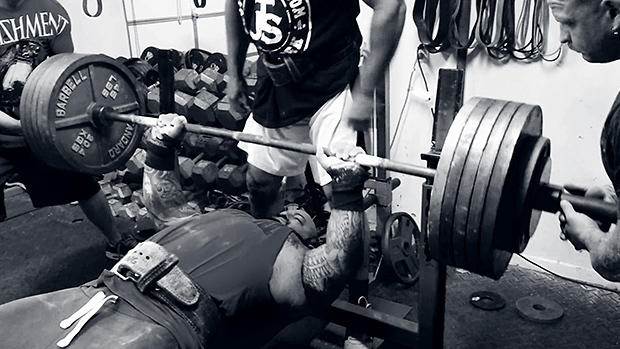
3. Cross Education – A Strong CNS
Now, there is a significant element of specificity in training. We know that the more you practice something, the better you become at it and you may be thinking, “Surely training to lower weights will only get you better at lowering weights?”
However, what most people don’t realize about the body, particularly the Central Nervous System (CNS), is that when placed under a significant amount of stress, positive adaptations can occur on a systemic, whole body level, in areas/movements that aren’t directly trained.
A classic example of this is known as cross education in orthopedic rehabilitation. It used to be the case (out of fear of muscle imbalances) that you didn’t want to train the unaffected limb. However, more recent knowledge has shown that unilateral strength training also increases the voluntary activation of the untrained limb (16).
Although this is a niche area of research, the findings stem beyond injury rehabilitation and provide even more evidence of what World Class Athletes/Coaches have known for years.
A strong CNS is a Strong CNS – regardless of what you tell it to do.
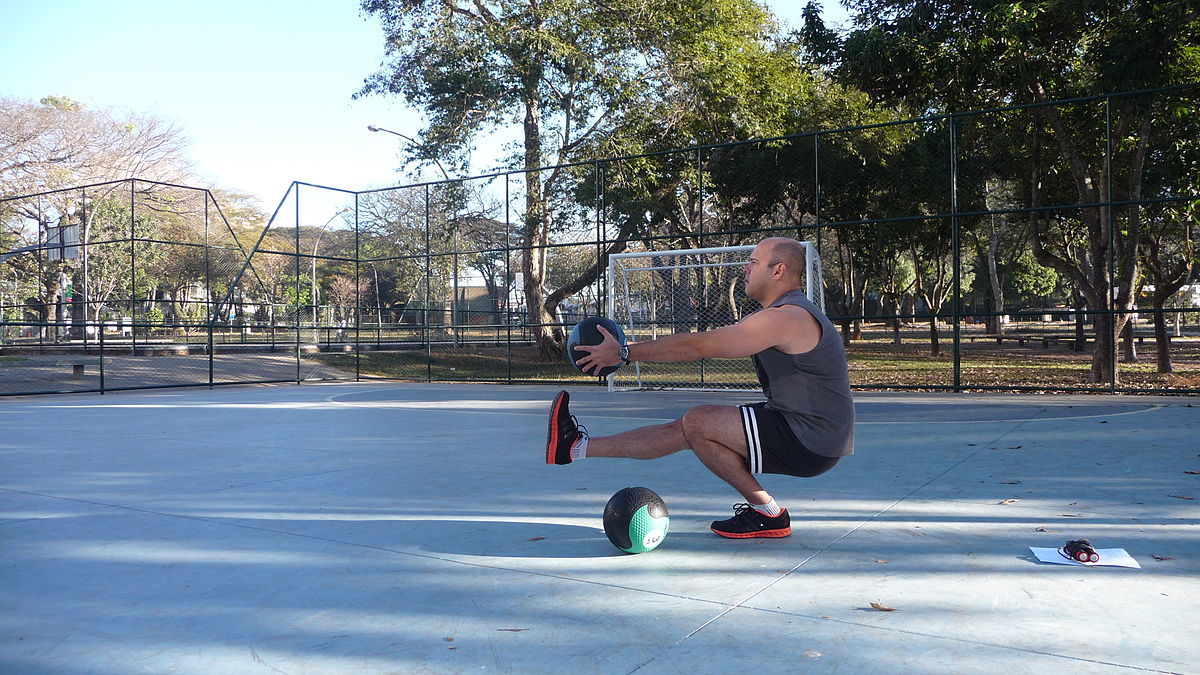
Experience Level – Is It For Me?
There are a few points to cover briefly, before we go into the training methodology – the main point being, is this the right training for you?
A key factor for the appropriate prescription of this training method is the experience level of the individual.
For all parties involves, eccentric training help to reinforce stability and as mentioned, improves technical feedback. In the case of the beginner, this is particularly valuable, so they can develop a consistent, safe and effective method of execution as early into their training development as possible.
Most people fall short in their pursuit of strength as they totally neglect the importance of tension and stability when lifting. I was a victim of this myself. You focus so much on the lifting that you lose your technique on a regular basis, all for nothing. Beginners, although they may not have directly increased their max, they would have been much more aware of their overall control within the movement.
Beginners Beware
However, there is a key consideration to factor in for a Novice Strength Trainee…will it even work?
Empirical research has shown similar gains between both traditional resistance training and eccentric overload training for untrained subjects (1, 24), without necessarily showcasing significantly greater strength improvements for the Eccentric focused group.
Now, usually, the fact that the volume wasn’t matched between groups – would be a fundamental flaw in study design. In one case, the eccentric training group gained the same increases in strength, but with approximately 40% less training time and a 15% lower overall volume (1). In the 2nd study, they prescribed similar rep and set schemes in a bid to standardized volume (24).
However, hold your horses ya little science nerd. Remember, during eccentric training, if you are using a significantly heavier load, your volume will naturally go up. So, you cannot (and should not) use the same sets x reps scheme, as this could very quickly lead to over- training, or a state in which you are unable to recover due to the significant muscle damage that takes place during eccentric training.
And, as we would expect, even with the volume reduction, this study found, the eccentric training group had a significantly greater lactic acid response; one of the proposed mechanisms behind delayed recovery.
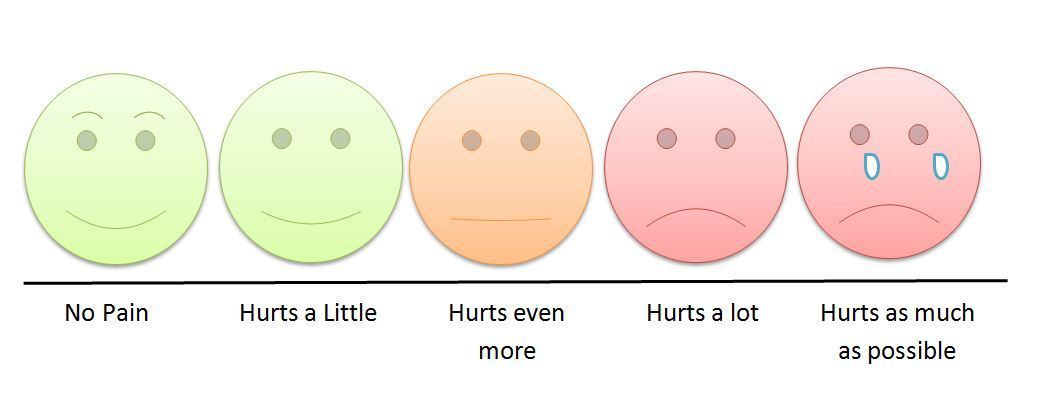
Stronger People Need More
Following on from the previous point, further research has highlighted that stronger subjects benefit more from the heavier eccentric loading (23), which may be explained by lower inhibition when tolerating heavy loads (4).
So if you squat 100kg, you may be able to benefit from 120kg eccentrics (+20%), but any higher may be too much for your body. Where as if you squat 200kg, you may be able to handle 260kg (+30%) and benefit from it.

PRACTICAL THOUGHTS...
As is often the case, the Devil is in the Detail. Eccentric training can be a useful method for everyone, the key is in appropriately scaling the method of it's implementation, and the dose - to the person who is performing it.
Typically, well trained individuals will tolerate far more training stress than a beginner due to the time spent under the bar, more efficient techniques and building a specific work capacity to training. As a result, they're going to be able to handle the extra loads that come from Overload Eccentrics without necessarily impairing their recovery.
However, it's important to highlight that even if you are a beginner, provided you opt to use a lighter load and monitor the volume you implement - Eccentrics can be a valuable tool for all who choose to perform them.
For the Ladies...
Something definitely worth noting is the difference between men and women in this respect. Although women recover much faster and basically have much higher durability then men, research has shown that women possess a greater difference between their eccentric and concentric strength, meaning they naturally have greater ability to lower a load than they do an ability to lift it (9).
Combine this with women tending to be more hyper-mobile and reduced joint stability, eccentric training is a great way to facilitate strength gains in women.
Flexibility
On top of everything else eccentric training has to offer, it can also help improve lower limb flexibility (21). If you struggle with squat depth, progressively increasing the load for eccentric based squats is a perfectly viable method!
WHY?
Learn the science and theory.
Muscle Architecture
You’re weak.
May be not you personally, especially in comparison to the people around you. But relative to other animals in the animal kingdom, it’s well known that humans are weak. Our biomechanical levers in each joint don’t favour us at all and then the metabolic cost of producing a concentric muscle contraction is quite high, compared to low cost eccentric contraction (12).

Although we may be weak, our muscles are designed to be much stronger and more efficient at lowering things or, performing eccentric contraction. In fact, some studies have documented that humans can produce 20-30% more force at the same level of activation during eccentric contraction (15) and we may be up to 60% stronger (8).
Cross Bridge Resistance
Here we go again, let’s get your nerd hat on and pull up your high waisted smart pants. A quick explanation of muscle contraction.
Within a muscle belly, we have something known as muscle fibres, which can be broken down further into sarcomeres. Within each sarcomere are what’s known as, myofilaments. Myofilaments form the foundation of muscular contraction and although there are other biochemical factors at play, these are the mechanical components of muscle. And muscle contraction occurs through a mechanism known as “Huxley’s Sliding Filament Theory”.

- Actin. The thinner filament containing the attachment site for myosin.
- Myosin. The thicker filament with the head that reaches up, attaches to actin and pulls itself along to contract the muscle.
- *Desmin & Titin. Don’t worry about these little guys. Not that important for now and the research is still fully clear on the importance of these other myofilaments, but in the interest of full disclosure, I thought I would rouse your curiosity by letting you know there’s actually a few newly discovered myofilaments that we previously weren’t aware of.
As you can see in the beautifully constructed image below – the action of muscle contraction shortens the muscle. The myosin heads are responsible, as they pull on the actin filaments and draw everything towards the midline.
However, during an eccentric contraction there is resistance of these myosin heads. They’re hooked in and don’t really fancy letting go, as a result they resist being pulled apart slightly (even without excessive neural stimulation from your own effort). This one of the factors that contributes to something known as “passive force enhancement” (17).
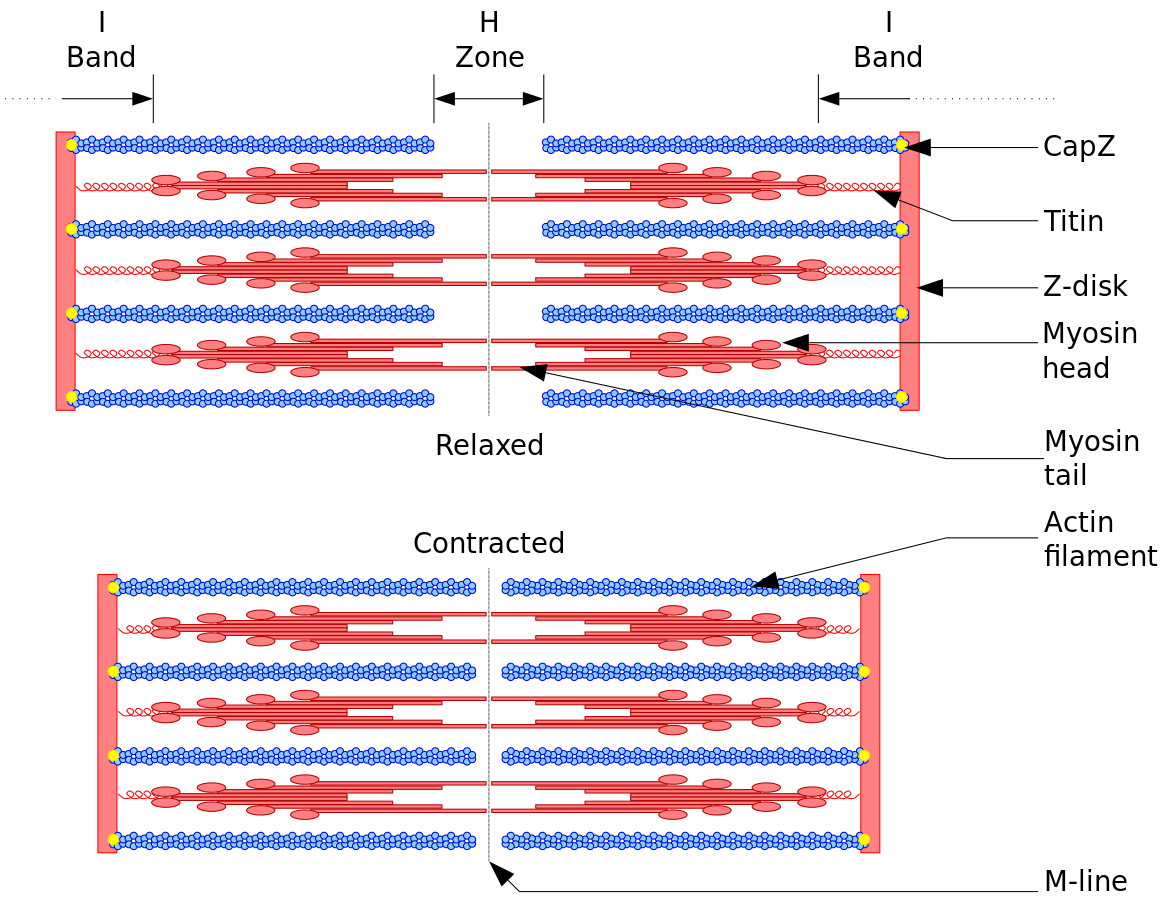
Higher Motor Unit Recruitment
As we have mentioned previously, the ability to maximally drive motor unit recruitment is the key to building relative strength.
Motor Units are sites of neural innervation into bundles of muscle fibre, that regulate contractile force – think of a “plug”, connecting the nervous system to the mechanical tissue.
Interestingly enough…
Evolutionary Architecture
We’ve spoken about this topic before if you want to read about it in a little more detail here, but to keep it simple today, our entire Neuromuscular Function is predicated on being able to perform two “movements”:
- Walking / Locomotion at Varying Speeds
- Breathing
Everything from that point onwards becomes secondary. Everyone talks about the “squat” being a natural, primal movement, but it doesn’t even come close to the influence that walking / ambulation has on our physiology.
And this is where we see ‘Eccentric Training’ move to the forefront as a key contraction mode to be trained.
You see, muscles have preferred actions, what we’ll call “Functions“.
Yes, your glute might “abduct” the hip, but in reference to walking, it prefers to “resist adduction”.
And this is true for almost all skeletal muscle – the action and the true function aren’t one and the same.
Here are just a few of the muscles involved in walking / running and how they truly function –
Let’s take a look at a couple of examples:
- Quadriceps – When walking, while they subtly aid in producing force and help propel you forward, they have a more important role in eccentrically, resisting your knee bending and isometrically stabilizing the joint. In fact, the only time your quadriceps really shorten is during the swing phase, when you reach your leg forward.
- Gluteus Maximus – The glutes obviously aid in all aspects of locomotion. However, they primarily eccentrically decelerate the leg along with the hamstring, before the heel touches the ground and then forcefully extend the hip.
- Glute Minimus, Medius and Tensor Fascia Lata – They function to eccentrically resist the knee caving inwards from the hip, and isometrically contract to maintain the stability within the pelvis during the support phase (i.e. when you’re stood on one leg).
*Anderson & Pandy (1).
HOW?
Learn the implementation.
Why Aren’t They More Common?
Two simple reasons –
- They’re initially, very humbling and very difficult – especially when it comes to recovery.
- They can be, logistically, a little difficult to implement.
You have to get quite creative and it can be a little inconvenient. Machines and pretty much all forms of equipment are constructed based on our love of lifting things rather than lowering them.
But before we go into specific exercises, we need to talk about the most important aspect –
Exercise Execution.
Regardless of what you do, how we do it needs to be addressed first.
Resistance Profiles – Pay Attention!
This is the hardest part for most people to understand, especially from a motor coordination point.
“Walk before you try and run”. This couldn’t be more true with all forms of strength training, but especially with eccentric training.
When coaching, I like to get everyone to imagine breaking a movement down into thirds.
- Short Range
- Mid Range
- Full Range
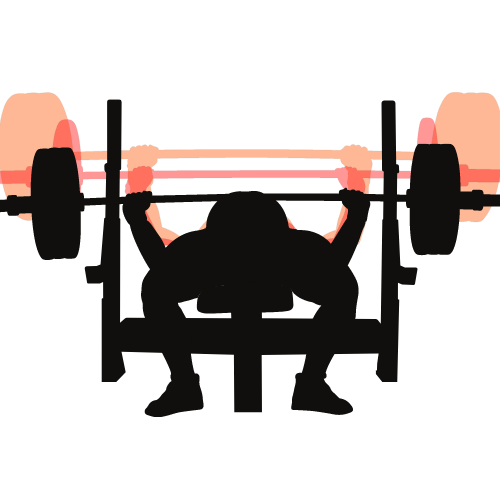
Each movement you’re performing will have a resistance profile, which will ultimately dictate where the point of peak tension is, and therefore where you’re most likely to “break”. Some muscles are weakest during their “stretch”, others during their “squeeze”.
I can’t stress this enough, so I want you to re-read the following sentence a few times over before moving on:
The greatest benefits of eccentric training, lie at the point of peak tension – so train it. The very bottom of the squat, as the bar is touching your chest on bench, as you lower the bar away from your body on a row – that’s the point that matters the most.
The movement should look smooth throughout. If you’re moving the bar slowly at first as you lower into a squat and then all of a sudden drop at the last minute – you won’t receive the true benefits.
Trust me – I made this mistake for years – wondering why eccentric were never giving me the gains they seemed to give everyone else.
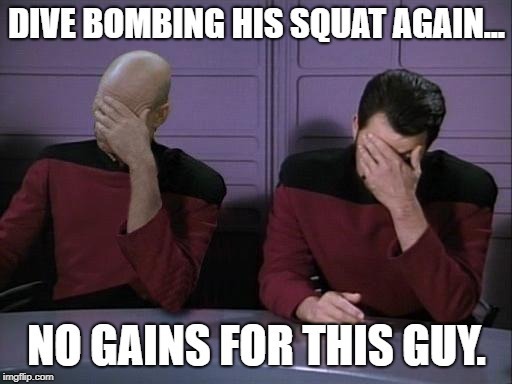
Maintaining control throughout the course of the whole movement is essential. This is obviously going to be much harder in the most stretched portion of the movement, but that’s where the fun begins!
1. Tempo / Prolonged Eccentrics
Research has shown that something often referred to as, “over-speed eccentrics”, in which you perform the eccentric contraction in a rapid manner, actually increases the force produced (14).
However, it takes a hell of a lot of skill to maintain tension and move rapidly. So, I almost never recommend this method (unless you’re highly trained) and instead prescribe a much more controlled duration.
The research itself is relatively ambiguous and I won’t dive into that too much at this point (considering the wealth of references above, chances are that’s enough science for today). However, you want to focus on the relationship between duration and fatigue.
The longer the duration during the lowering phase, the greater the fatigue response will be and therefore, adversely affect the concentric phase.
This isn’t necessarily a bad thing – after all, we’re doing this variation specifically for the benefits eccentric contractions bring – it just influences the loading you’re going to use.
2. Overload Eccentrics – Weight Releasers
The more advanced method of implementing eccentrics includes overload work, using weight releasers.
When used correctly, these niche pieces of equipment allow you to correct the evolutionary imbalance of our eccentric bias, and provide additional overload to the lowering phase.
It’s a common mistake people make when using/focusing on eccentrics or tempo. They slow down way too much and end up not using a load that is actually overloading their maximal strength.
Anywhere between 3-6 seconds is recommended and has been used within most of the studies quoted above.
3. 2 More ‘Outside the Box’ Methods
Bi to Unilateral
If you’re using machine work in isolation exercises or bodyweight exercises, you can use two limbs to lift and one to lower.
Think about a leg extension machine – use two to extend, then take pressure off one leg and lower with only one.
Or a body-weight squat to a box – use two legs to stand up, then perform a single leg/pistol squat down to the box.
Power Rack or Blocks
- Squat – Although very inconvenient, it’s possible to perform overload eccentrics down to blocks or safety pins that can catch the bar for you. You step out, strip some weight off, lift back up and repeat.
A great video demonstration of this is given here by Dr. Joel Seedman.
- Deadlift – Deadlift from blocks (due to the shorter range of motion you can usually lift more), have someone move the blocks away and perform the eccentric phase of the movement.
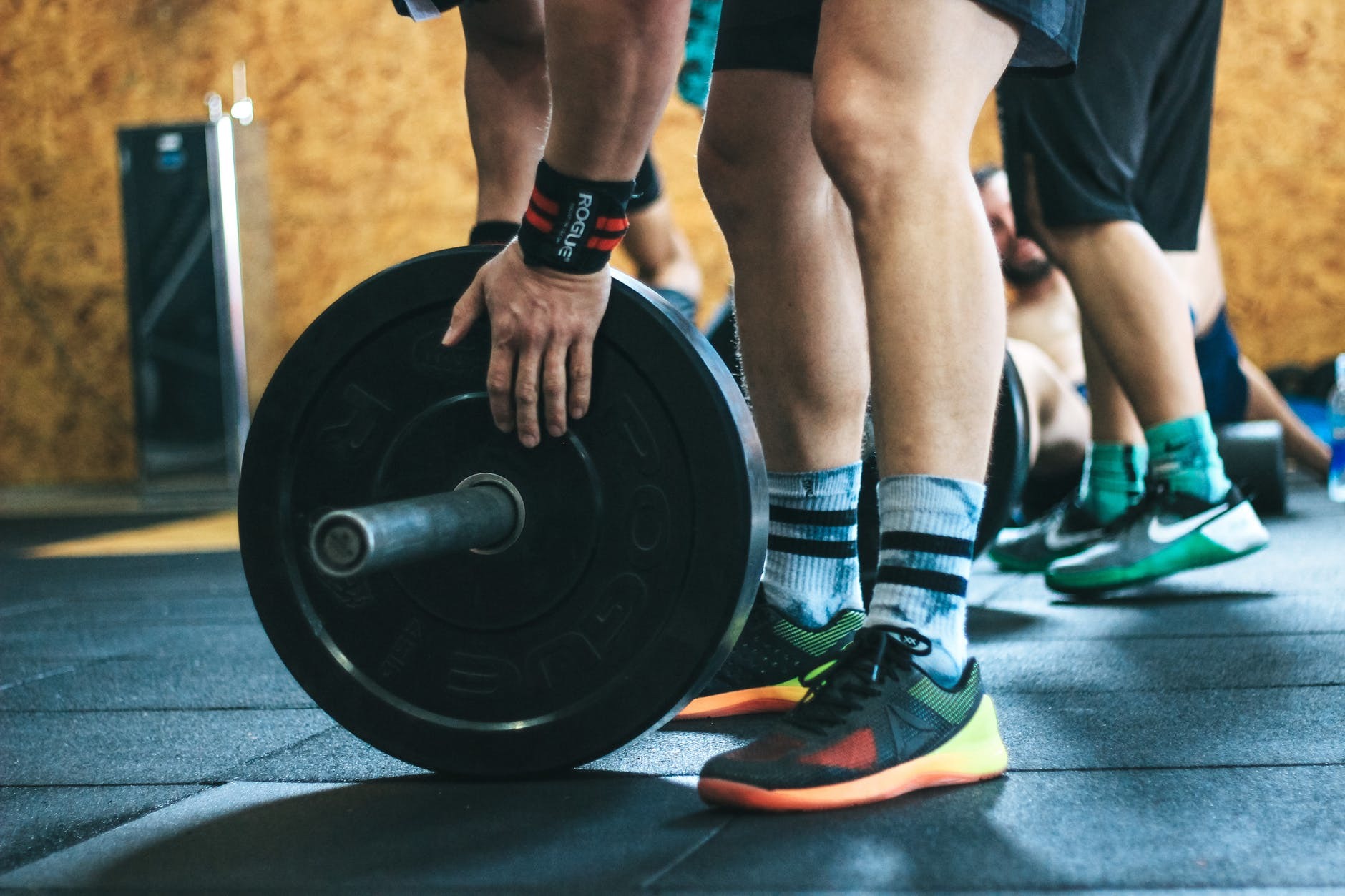
Precautions
Recovery
They’re harder to recover from. It’s that simple.
Some people will agree…others will snort at this and think, “Yeah but I recover quicker than most”. I did, for a few training cycles before I realised.
If you’re performing true Eccentric Training with compound movements such as the back squat, bench press etc. the intensity is so great, then you will need a little more time to recover compared to traditional dynamic training.
Training Status
Eccentric training isn’t for everyone. Everyone can benefit, but for significantly different reasons.
- Beginners – It is recommended to use eccentric training to reinforce stability, but this can be done by simply focusing on slowing the duration of the eccentric portion during normal lifts.
- Advanced – this is where supra-maximal (i.e more weight than you can physically lift) training comes into play. However, it needs to be noted that due to the heavier weights, the chance of injury may increase if not done correctly. It’s also recommended to use a spotter or training partner to make sure everything goes well throughout the lift.
SUMMARY
- Eccentric training refers to emphasizing or isolation the lowering portion of an exercise.
- Humans are architecturally designed to be more efficient in eccentric contraction compared to concentric contractions – we’re up to 60% stronger eccentrically!
- Research has shown it to produce significantly greater progress compared to concentric based training, potentially due to greater overload to the nervous system.
- There are several reasons behind why we are stronger eccentrically: one of which being the passive force enhancement during cross bridge cycling.
- Although applicable for more or less everyone, it appears to be most effective for: beginners to reinforce stability, advanced to overload the nervous system and female trainees.
- When using eccentric only training with heavier loads, make sure you decrease the reps and sets to decrease your overall volume. Otherwise, the extra loads will inevitably impair your recovery.
- Tempo, Consistency and Overall Logistics of implementation are often the barrier to this type of training. But don’t let that stop you!
- Anderson, F. C., & Pandy, M. G. (2003). Individual muscle contributions to support in normal walking. Gait & posture, 17(2), 159-169
- Barstow, I. K., Bishop, M. D., & Kaminski, T. W. (2003). Is enhanced-eccentric resistance training superior to traditional training for increasing elbow flexor strength?. Journal of sports science & medicine, 2(2), 62
- Bruemmer, V., Schneider, S., Abel, T., Vogt, T., & Strueder, H. K. (2011). Brain cortical activity is influenced by exercise mode and intensity. Medicine & Science in Sports & Exercise, 43(10), 1863-1872
- Douglas, J., Pearson, S., Ross, A., & McGuigan, M. (2017). Chronic adaptations to eccentric training: a systematic review. Sports Medicine, 47(5), 917-941
- Enoka, R. M. (2008). Neuromechanics of human movement. Human kinetics.
- Fang, Y., Siemionow, V., Sahgal, V., Xiong, F., & Yue, G. H. (2001). Greater movement-related cortical potential during human eccentric versus concentric muscle contractions. Journal of Neurophysiology, 86(4), 1764-1772
- Flanagan, S. D., Dunn-Lewis, C., Comstock, B. A., Maresh, C. M., Volek, J. S., Denegar, C. R., & Kraemer, W. J. (2012). Cortical activity during a highly-trained resistance exercise movement emphasizing force, power or volume. Brain sciences, 2(4), 649-666
- Friedmann-Bette, B., Bauer, T., Kinscherf, R., Vorwald, S., Klute, K., Bischoff, D., ... & Bärtsch, P. (2010). Effects of strength training with eccentric overload on muscle adaptation in male athletes. European journal of applied physiology, 108(4), 821-836
- Higbie, E. J., Cureton, K. J., Warren III, G. L., & Prior, B. M. (1996). Effects of concentric and eccentric training on muscle strength, cross-sectional area, and neural activation. Journal of Applied Physiology, 81(5), 2173-2181
- Hollander, D. B., Kraemer, R. R., Kilpatrick, M. W., Ramadan, Z. G., Reeves, G. V., Francois, M., ... & Tryniecki, J. L. (2007). Maximal eccentric and concentric strength discrepancies between young men and women for dynamic resistance exercise. The Journal of Strength & Conditioning Research, 21(1), 37-40.
- HortobÁgyi, T., Devita, P., Money, J., & Barrier, J. (2001). Effects of standard and eccentric overload strength training in young women. Medicine & Science in Sports & Exercise, 33(7), 1206-1212.
- Howell, J. N., Fuglevand, A. J., Walsh, M. L., & Bigland-Ritchie, B. (1995). Motor unit activity during isometric and concentric-eccentric contractions of the human first dorsal interosseus muscle. Journal of Neurophysiology, 74(2), 901-904
- Isner-Horobeti, M. E., Dufour, S. P., Vautravers, P., Geny, B., Coudeyre, E., & Richard, R. (2013). Eccentric exercise training: modalities, applications and perspectives. Sports medicine, 43(6), 483-512
- Kaminski, T. W., Wabbersen, C. V., & Murphy, R. M. (1998). Concentric versus enhanced eccentric hamstring strength training: clinical implications. Journal of athletic training, 33(3), 216
- Komi, P. V. (1973). Measurement of the force-velocity relationship in human muscle under concentric and eccentric contractions. In Biomechanics III(Vol. 8, pp. 224-229). Karger Publishers.
- Komi, P. V. (1986). Training of muscle strength and power: interaction of neuromotoric, hypertrophic, and mechanical factors. International Journal of Sports Medicine, 7(S 1), S10-S15
- Lee, M., Gandevia, S. C., & Carroll, T. J. (2009). Unilateral strength training increases voluntary activation of the opposite untrained limb. Clinical Neurophysiology, 120(4), 802-808
- Leonard, T. R., DuVall, M., & Herzog, W. (2010). Force enhancement following stretch in a single sarcomere. American Journal of Physiology-Cell Physiology, 299(6), C1398-C1401
- Matthews, P. B. (1991). The human stretch reflex and the motor cortex. Trends in neurosciences, 14(3), 87-91
- Moritani, T., Muramatsu, S., & Muro, M. (1987). Activity of motor units during concentric and eccentric contractions. American journal of physical medicine, 66(6), 338-350
- Nakazawa, K., Kawakami, Y., Fukunaga, T., Yano, H., & Miyashita, M. (1993). Differences in activation patterns in elbow flexor muscles during isometric, concentric and eccentric contractions. European journal of applied physiology and occupational physiology, 66(3), 214-220
- O'Sullivan, K., McAuliffe, S., & DeBurca, N. (2012). The effects of eccentric training on lower limb flexibility: a systematic review. Br J Sports Med, bjsports-201
- Romano, C., & Schieppati, M. (1987). Reflex excitability of human soleus motoneurones during voluntary shortening or lengthening contractions. The Journal of physiology, 390(1), 271-284
- Sheppard, J. M., & Young, K. (2010). Using additional eccentric loads to increase concentric performance in the bench throw. The Journal of Strength & Conditioning Research, 24(10), 2853-2856.
- Yarrow, J. F., Borsa, P. A., Borst, S. E., Sitren, H. S., Stevens, B. R., & White, L. J. (2008). Early-phase neuroendocrine responses and strength adaptations following eccentric-enhanced resistance training. The Journal of Strength & Conditioning Research, 22(4), 1205-1214
- Yue, G. H., Liu, J. Z., Siemionow, V., Ranganathan, V. K., Ng, T. C., & Sahgal, V. (2000). Brain activation during human finger extension and flexion movements. Brain Research, 856(1-2), 291-300


